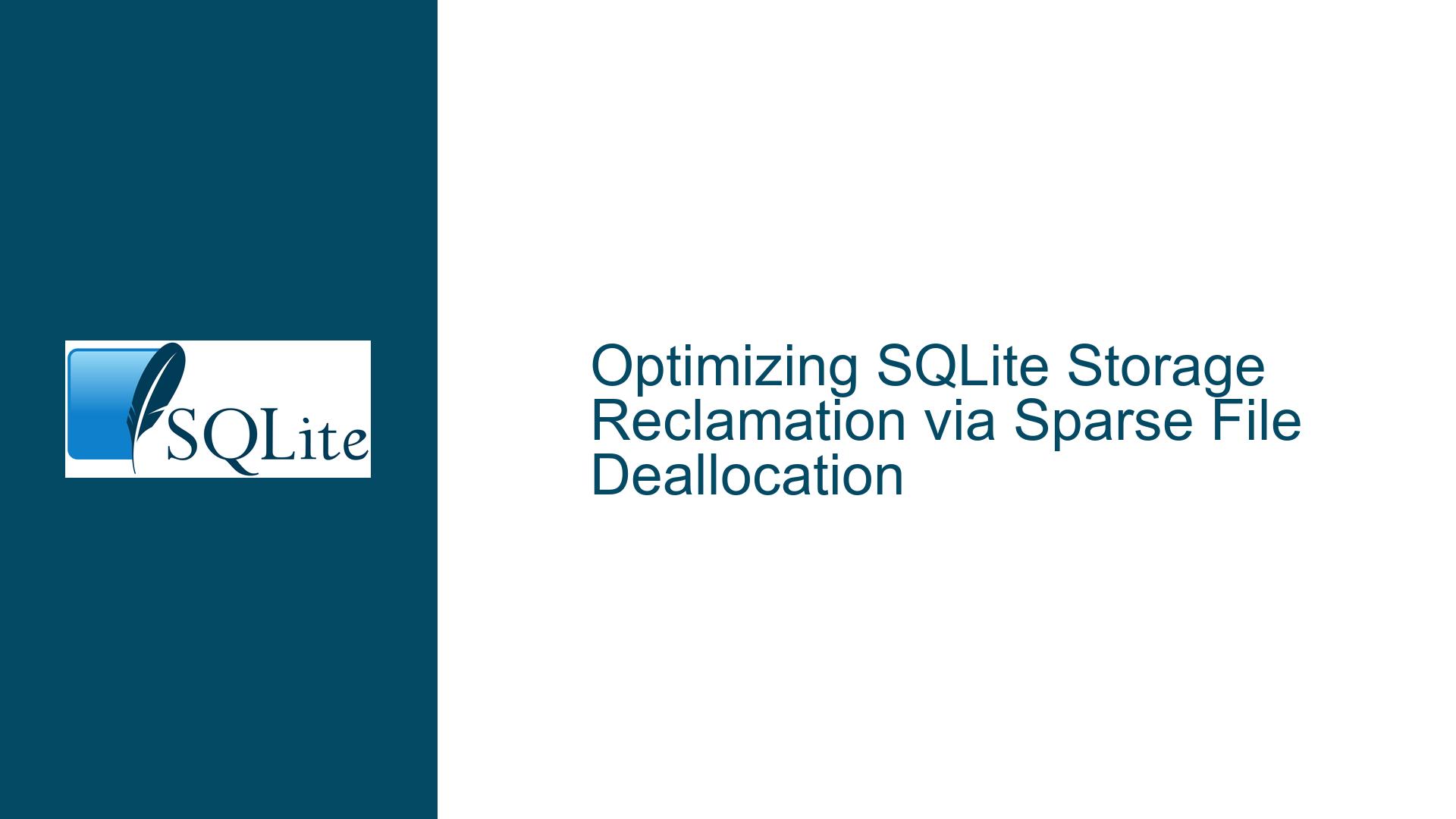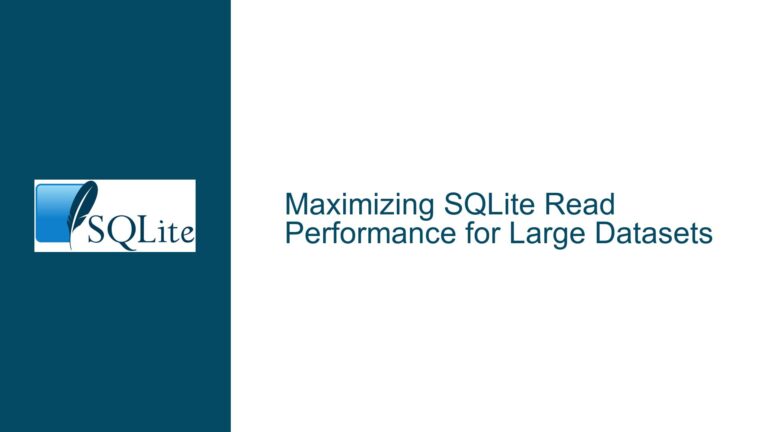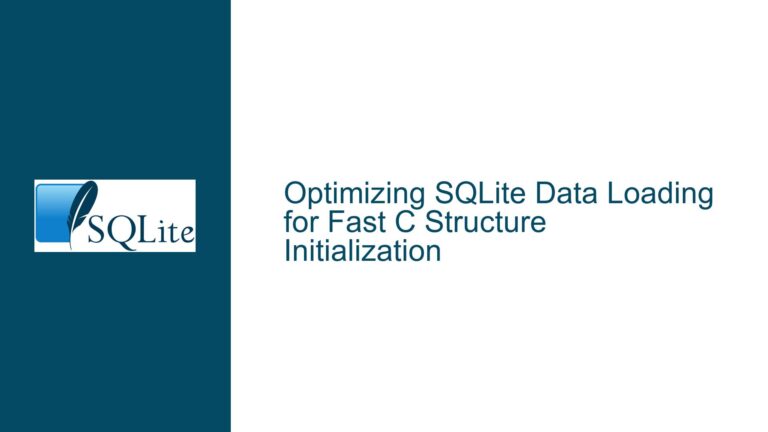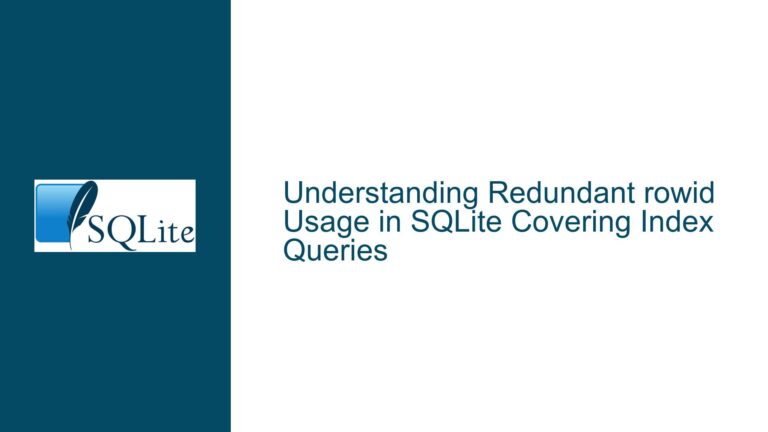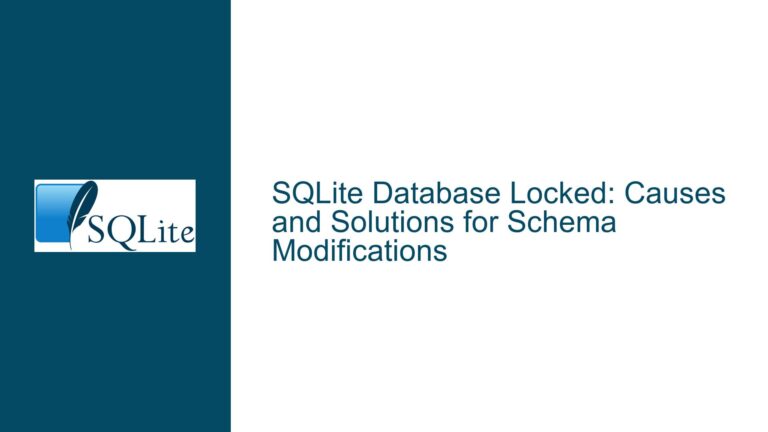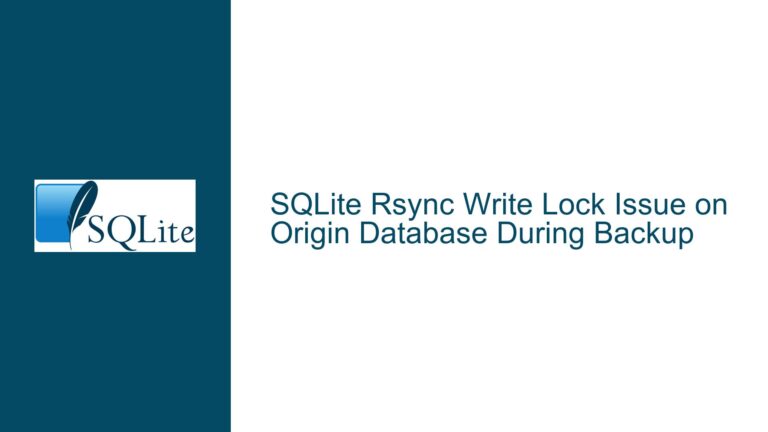Optimizing SQLite Storage Reclamation via Sparse File Deallocation
Understanding SQLite Free Page Management and Sparse File Deallocation Challenges
Issue Overview: SQLite Free Pages and the Case for Sparse File Deallocation
SQLite databases grow dynamically as data is inserted, updated, or indices are rebuilt. When objects like tables or indices are dropped, their associated pages are moved to a freelist – a linked list of pages marked as reusable. By default, SQLite does not release these pages back to the operating system’s file system. Instead, they remain allocated within the database file, consuming physical storage. This design choice prioritizes write performance: reusing existing free pages avoids frequent file truncation or sparse block management, which can introduce latency.
However, for large databases (e.g., 300+ GB) or systems with constrained storage, retaining unused pages becomes problematic. Consider a scenario where an application creates and drops a 800 MB index repeatedly. Each iteration leaves behind a growing pool of free pages that occupy disk space indefinitely. Traditional solutions like VACUUM or PRAGMA auto_vacuum = FULL address this by reorganizing the database and truncating the file. VACUUM copies live data to a new file, discarding free pages, but requires temporary storage equal to the original database and incurs significant I/O overhead. auto_vacuum = FULL moves pages to the end of the file during transactions and truncates incrementally, but introduces write amplification and latency.
The proposed alternative leverages sparse file support in modern file systems (NTFS, APFS, ext4). Sparse files allow regions of a file to be "hole-punched," deallocating their underlying storage while retaining logical offsets. For example, if pages 1000–2000 are free, issuing fallocate(FALLOC_FL_PUNCH_HOLE) on Linux or fcntl(F_PUNCHHOLE) on macOS marks these regions as unallocated. The file’s logical size remains unchanged, but physical storage is reclaimed. Subsequent reads to these regions return zeros, and writes reallocate storage transparently.
Key advantages of sparse file deallocation include:
- Immediate storage reclamation without temporary files or full-database rewrites.
- Reduced I/O operations compared to
VACUUM, which rewrites the entire database. - Compatibility with existing SQLite workflows, as the database remains valid after deallocation.
However, integrating this into SQLite introduces complexities. The database engine must track free pages accurately, handle platform-specific system calls, and ensure atomicity during deallocation. Moreover, sparse files behave differently across operating systems, and deallocated regions may impact performance if reused later.
Potential Pitfalls: Why SQLite Doesn’t Natively Deallocate Free Pages
Platform Heterogeneity and File System Quirks
While sparse files are widely supported, their implementation details vary. For instance:- On Linux,
fallocate(FALLOC_FL_PUNCH_HOLE)requires theFALLOC_FL_KEEP_SIZEflag to avoid changing the file size. - Windows uses
FSCTL_SET_ZERO_DATAto zero ranges, which may not deallocate space unless the file system supports trimming. - macOS’s
fcntl(F_PUNCHHOLE)behaves differently on APFS vs. HFS+, particularly regarding alignment requirements.
SQLite’s design philosophy emphasizes portability and reliability. Introducing platform-specific storage reclamation would complicate the codebase and require extensive testing across all supported OS/file system combinations.
- On Linux,
Fragmentation and Write Performance
Deallocating free pages creates "holes" in the database file. When SQLite later writes to these regions, the file system must allocate new blocks, potentially scattering data across the storage medium. While modern SSDs mitigate seek penalties, fragmentation can still degrade performance on HDDs or in low-memory environments where read-ahead caching is less effective.By contrast, SQLite’s
auto_vacuum = FULLmode consolidates free pages at the end of the file, ensuring new allocations occur sequentially. This minimizes fragmentation but requires periodic truncation.Transactional Integrity and Edge Cases
SQLite guarantees ACID properties through atomic page writes and rollback journals/WAL. Deallocating pages mid-transaction could introduce race conditions: if a transaction rolls back after deallocation, SQLite expects the original page content to be intact. However, deallocated pages return zeros when read, violating crash recovery assumptions.For example, consider a scenario where:
- Page 100 is marked free and deallocated.
- A new transaction allocates page 100, writes data, but crashes before committing.
- On recovery, SQLite checks the rollback journal and finds page 100 was part of an uncommitted transaction. It attempts to restore the original content, but the page now contains zeros instead of pre-transaction data.
This violates the durability guarantee, as deallocated pages cannot be restored to their pre-transaction state.
Interaction with Existing Features
- Secure Delete:
PRAGMA secure_delete = ONoverwrites freed pages with zeros. Deallocating pages achieves a similar effect (returning zeros on read) but via different mechanisms. However, secure_delete ensures data remnants are erased from physical storage, whereas deallocation merely marks blocks as unused – original data may persist until overwritten. - Incremental VACUUM:
PRAGMA incremental_vacuum(N)frees up to N pages from the freelist, truncating the file. This operates at the SQLite level, not the file system, and does not create sparse regions.
- Secure Delete:
Testing and Maintenance Burden
As noted in the discussion, SQLite’s VFS abstraction layer would require new methods to support sparse deallocation. Each VFS implementation (unix, win32, etc.) would need platform-specific code, increasing maintenance costs. Furthermore, validating correct behavior across edge cases (e.g., power loss during deallocation) demands extensive test harness updates.
Implementing Sparse File Deallocation: Solutions and Best Practices
1. External Tool Approach (Non-Intrusive)
The original proof-of-concept tool (sqlite_sparse) demonstrates how to deallocate free pages externally. This avoids modifying SQLite itself and can be integrated into maintenance scripts.
Steps for Safe Deallocation:
- Identify Free Pages: Query
sqlite_dbpage(if enabled) or parse the database freelist.PRAGMA schema.freelist_count; -- Returns number of free pagesFor detailed inspection, enable the
dbstatvirtual table:CREATE VIRTUAL TABLE temp.freelist USING dbstat(schema); SELECT pgno FROM freelist WHERE path LIKE '%freelist%'; - Deallocate Using Platform APIs:
Linux:fallocate(fd, FALLOC_FL_PUNCH_HOLE | FALLOC_FL_KEEP_SIZE, offset, length);macOS:
fstore_t fst = { F_ALLOCATECONTIG, F_PEOFPOSMODE, 0, length, 0 }; fcntl(fd, F_PREALLOCATE, &fst); fcntl(fd, F_PUNCHHOLE, &(struct fpunchhole){ offset, length });Windows:
FILE_ZERO_DATA_INFORMATION fzdi = { offset, offset + length }; DeviceIoControl(fd, FSCTL_SET_ZERO_DATA, &fzdi, sizeof(fzdi), NULL, 0, &bytesReturned, NULL); - Validate Post-Deallocation:
UsePRAGMA integrity_checkto ensure database consistency. Verify physical storage reduction viadu --apparent-size(Linux) orfsutil sparse queryall(Windows).
Limitations:
- Requires exclusive access to the database during deallocation.
- May interfere with SQLite’s page cache if the database is open.
- Does not prevent SQLite from reusing deallocated pages, which could negate storage savings.
2. Modifying SQLite’s Freelist Handling
To integrate deallocation into SQLite, extend the sqlite3PagerTruncate function (responsible for truncating the database file during VACUUM). When pages are moved to the freelist, issue platform-specific deallocate calls.
Proposed Workflow:
- Track Free Pages: Maintain a bitmap of deallocated pages in the database header.
- Deallocate on Commit: After a transaction commits, deallocate pages added to the freelist.
- Reallocate on Demand: When allocating a page from the freelist, check if it’s deallocated. If so, extend the file (if necessary) and write zeros to force storage reallocation.
Code Modifications:
- VFS Methods: Add
xShrinkorxDeallocatemethods to the VFS interface.struct sqlite3_io_methods { // ... int (*xShrink)(sqlite3_file*, sqlite3_int64 offset, sqlite3_int64 length); }; - Freelist Traversal: Modify
sqlite3BtreeCommitPhaseOneto iterate through the freelist and invokexShrinkfor each free page.
Testing Considerations:
- Crash Recovery: Ensure deallocated pages do not break rollback or WAL recovery.
- Cross-Platform Validation: Verify behavior on ext4, APFS, NTFS with varying block sizes.
- Performance Benchmarks: Measure transaction latency and storage fragmentation after deallocation.
3. Hybrid Approach: Incremental Deallocation
Combine PRAGMA incremental_vacuum with sparse deallocation. After vacuuming N pages, deallocate the truncated portion of the file. This avoids fragmenting the middle of the database.
Example Workflow:
PRAGMA auto_vacuum = INCREMENTAL;
-- Periodically:
PRAGMA incremental_vacuum(1000); -- Truncate 1000 pages
-- Deallocate the truncated region at the file's end
Advantages:
- Limits deallocation to the file’s end, reducing fragmentation.
- Leverages existing, well-tested vacuum logic.
4. User-Defined Functions (UDFs) for Deallocation
Expose deallocation via a loadable extension, avoiding core SQLite changes.
Sample UDF:
#include <sqlite3ext.h>
SQLITE_EXTENSION_INIT1
static void sparseDeallocate(sqlite3_context *ctx, int argc, sqlite3_value **argv) {
sqlite3 *db = sqlite3_context_db_handle(ctx);
const char *schema = (const char*)sqlite3_value_text(argv[0]);
// Acquire file handle, iterate freelist, deallocate pages...
}
int sqlite3_sparse_init(sqlite3 *db, char **pzErrMsg, const sqlite3_api_routines *pApi) {
SQLITE_EXTENSION_INIT2(pApi);
sqlite3_create_function(db, "sparse_deallocate", 1, SQLITE_UTF8, NULL, &sparseDeallocate, NULL, NULL);
return SQLITE_OK;
}
Usage:
SELECT sparse_deallocate('main');
5. Operational Best Practices
- Monitor Freelist Size: Regularly check
PRAGMA schema.freelist_countand deallocate when exceeding a threshold. - Schedule Deallocation During Off-Peak Hours: Avoid contention with critical transactions.
- Combine with Compression: Use ZFS/Btrfs transparent compression or SQLite’s
zipfileextension to further reduce storage. - Benchmark Storage Savings: Tools like
completion.dbon APFS may show higher savings than NTFS due to copy-on-write semantics.
6. Addressing Fragmentation Concerns
- Defragmentation Tools: Periodically
VACUUM INTOa new database to rebuild the file contiguously. - File System-Level Trim: On SSDs, issue
fstrim(Linux) orOptimize-Volume(Windows) to inform the controller of deallocated blocks.
7. Future Directions for SQLite Core Integration
While official adoption is uncertain, potential pathways include:
- New PRAGMA Command:
PRAGMA deallocate_freelistto trigger on-demand deallocation. - Extended Secure Delete: Merge deallocation into
PRAGMA secure_delete = FAST, using hole-punching instead of zeroing. - Community Extensions: Develop a separately maintained VFS shim (e.g.,
sparsevfs.c) that intercepts page writes and manages deallocation.
By understanding the trade-offs between storage reclamation, performance, and fragmentation, developers can adopt sparse file deallocation where appropriate while mitigating risks through careful testing and operational hygiene.
